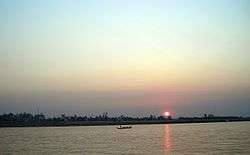Greater Mekong Subregion


The Greater Mekong Subregion, or just Greater Mekong, is an international region of the Mekong River basin in Southeast Asia. The region is home to more than 300 million people and was designated with the launch of a development project formed in 1992 by the Asian Development Bank, that brought together the six states of Cambodia, Laos, Myanmar, Thailand, Vietnam, and Yunnan Province, China.[1]
Greater Mekong holds irreplaceable natural and cultural riches and is considered one of the world's most significant biodiversity hotspot. The region is a very important food provider and the site of many large-scale construction projects with social and economic implications.[2]
Geology and biodiversity
The region has a diverse geographic landscape including massifs, plateaus, and limestone karsts, lowlands, fertile floodplains and deltas, forests (evergreen and semi-evergreen, deciduous, dipterocarp, mangroves, and swamp), and grasslands. Water environments include fast-flowing rocky mountain streams and wetlands (such as Tonlé Sap in Cambodia).[3]
The region's geographic variety and consequent variety of climatic zones supports significant biodiversity, with more than 1,068 new species discovered during the last ten years. The geographic region encapsulates 16 of the WWF Global 200 ecoregions, and habitats for an estimated 20,000 plant species, 1,300 fish species, 1,200 bird species, 800 reptile and amphibian species, and 430 mammal species. Notable species include the Javan rhino, Irrawaddy dolphins, and Mekong giant catfish (one of the largest freshwater fish).[3]
The region's biodiversity is ranked as a top-five most threatened hotspot by Conservation International. The WWF cites accelerating economic development, population growth and increased consumption patterns as primary causes, including agricultural deforestation, logging and illegal timber trade, wildlife trade, overfishing, dam and road construction, and mining. The WWF also states that the region is particularly vulnerable to global climate change.[3]
Conservation
With the rapid development in the region, conservation efforts to protect natural resources, habitats, biodiversity and local cultures in the Greater Mekong has become urgent. The most pressing current threats are hydropower development, climate change, illegal wildlife trade, and habitat loss.[2]
Construction and industry
The harvesting and production of natural ressources in the Greater Mekong Subregion (sometimes abbreviated GMS) is of significant economic importance, with the retail value of Mekong river fisheries alone estimated at more than US$4 billion annually.[4]
In the last decades, the Greater Mekong Subregion has also become a major site for large-scale construction projects and a rapid economic development, including hydropower damming, mining, forestry and industrial productions.[2]
The combination of these factors has raised environmental concerns internationally since the mid 2000s. For now, it has resulted in formulation of environmental programmes and strategy proposals and strategy developments of a sustainable green growth economy for this region. It has been attained by influential organizations like the United Nations (UNEP and FAO), WWF, PROFOR and others, in high-level collaboration with the governmental ministries of the countries comprising the Greater Mekong Subregion.[4] [5][6][7]
Organizations
Notable organizations involved in the Greater Mekong Subregion includes:
- Mekong River Commission (MRC)
- Asian Development Bank (ADB)
- Greater Mekong Subregion Academic and Research Network (GMSARN)
- United Nations
- Food and Agriculture Organization of the United Nations (FAO)
- United Nations Environment Programme (UNEP)
- World Wide Fund for Nature (WWF)
- Programme on Forests (PROFOR)
- Open Development Mekong, founded by the EastWest Institute
See also
- Asian Development Bank
- GMS Environment Operations Center
- Greater Mekong Sub-region Academic and Research Network
- Indochina
- Mekong Delta
- Mekong River
- Subregion
References
- ↑ "Discovering the Greater Mekong". WWF. Retrieved 18 November 2015.
- 1 2 3 "Greater Mekong". WWF. Retrieved 18 November 2015.
- 1 2 3 First Contact in the Greater Mekong: new species discoveries, World Wide Fund for Nature
- 1 2 "Green Economy in the Greater Mekong". WWF. Retrieved 18 November 2015.
- ↑ "UNEP - Regional Office for Asia Pacific - Mainstreaming Environment through Regional Forums". UNEP. Retrieved 18 November 2015.
- ↑ "Mekong River Commission (MRC)". FOA. Retrieved 18 November 2015.
- ↑ "Forest Law Enforcement and Governance in the Mekong Region". Program on Forests (PROFOR). 12 April 2011. Retrieved 19 November 2015.
External links
- GMS-EOC (ADB): Core Environment Program
- A brief history of ASEAN's role in the GMS
- GMS nations meet to fight human trafficking
- Greater Mekong Subregion Economic Cooperation Program - Overview
- Countries of the Mekong River: The Greater Mekong Subregion
- Greater Mekong Subregion Environment Operations Center
- Asian Development Bank (ADB): Greater Mekong Subregion Overview
- Greater Mekong Subregion Studies Center | Nakhon Phanom University
- Thailand's Learning Across Boundaries in the GMS
- United Nations map of the Mekong Subregion
- World Wildlife Federation's GMS website